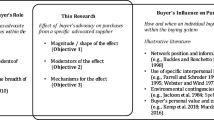Abstract
Purchasing agents are often employed as individual informants in studies of organizational buying. This practice occurs in spite of the fact that several researchers have identified problems with using individual informants to study group buying behavior. The purpose of this study is to examine the appropriateness of using either single or multiple informants both in non-new task and new task group buying situations. We compare the predictive accuracy of a single-informant, autocracy model with that of a multiperson, majority rule model. The study includes 104 group decisions made by buying centers in organizations. Overall, we find that data from multiple informants significantly outperforms single informant data for both new task and non-new task situations, and that single/key informant data should be used in organizational buying research only with care and caution.
Similar content being viewed by others
References
Campbell, Donald T. (1955). “The Informant in Quantitative Research,”American Journal of Sociology 60, 339–342.
Choffray, Jean-Marie, and Gary L. Lilien. (1980).Market Planning for New Industrial Products. New York: John Wiley and Sons.
Corfman, Kim P., and Sunil Gupta. (1992). “Mathematical Models of Group Choice.” In J. Eliashberg and G. L. Lilien (eds.),OR/MS in Marketing Handbook, forthcoming, New York, NY: Elsevier.
Corfman, Kim P., and Donald R. Lehmann. (1987). “Models of Cooperative Group Decision-Making and Relative Influence: An Experimental Investigation of Family Purchase Decisions,”Journal of Consumer Research 14 (June), 1–13.
Denzin, Norman K. (1978).Sociological Methods: A Sourcebook. New York, NY: McGraw-Hill.
Gensch, Dennis H., Nicola Aresa, and Steven P. Moore. (1990). “A Choice Modelling Market Information System that Enabled ABB Electric to Expand Its Market Share,”Interfaces 20(1), 6–25.
Hastings, N. A. J., and J. B. Peacock. (1975).Statistical Distributions. New York: John Wiley and Sons.
Jackson, Donald W., Janet E. Keith, and Richard K. Burdick. (1984). “Purchasing Agents' Perceptions of Industrial Buying Center Influence: A Situational Approach,”Journal of Marketing 48 (Fall), 75–83.
Kohli, Ajay. (1989). “Determinants of Influence in Organizational Buying: A Contingency Approach,”Journal of Marketing 53 (July), 50–65.
Kriewall, Mary Ann Odegaard. (1980). “Modeling Multi-Person Decision Processes on a Major Consumption Decision,” unpublished dissertation, Stanford University.
Mead, Margaret. (1953). “The Study of Culture at a Distance.” In Margaret Mead and Rhoda Metraux,The Study of Culture at a Distance. Chicago, IL: University of Chicago Press, 3–53.
Moriarty, Rowland T., and John E. G. Bateson. (1982). “Exploring Complex Decision Making Units: A New Approach,”Journal of Marketing Research 19 (May), 182–191.
Naumann, Earl, Douglas J. Lincoln, and Robert D. McWilliams. (1984). “The Purchase of Components: Functional Areas of Influence,”Industrial Marketing Management 13; 113–122.
Nisbett, Richard E., and Timothy D. Wilson. (1977). “Telling More Than We Can Know: Verbal Reports on Mental Processes,”Psychological Review 84, 231–259.
Patton, Wesley E., Christopher P. Puto, and Ronald H. King. (1986). “Which Buying Decisions are Made by Individuals and Not by Groups?”Industrial Marketing Management 15, 129–138.
Phillips, Lynn W. (1981). “Assessing Measurement Error in Key Informant Reports: A Methodological Note on Organizational Analysis in Marketing,”Journal of Marketing Research 18 (November), 395–415.
Puto, Christopher P., Wesley E. Patton, and Ronald H. King. (1985). “Risk Handling Strategies in Industrial Vendor Selection Decisions,”Journal of Marketing 49 (Winter), 98.
Silk, Alvin J., and Manohar U. Kalwani, (1982). “Measuring Influence in Organizational Purchase Decisions,” 19 (May), 165–181.
Steckel, Joel H., Kim P. Corfman, David J. Curry, Sunil Gupta, and James Shanteau. (1991). “Prospects and Problems in Modeling Group Decisions,”Marketing Letters 2(3), 231–240.
Vyas, Niren, and Arch G. Woodside. (1984). “An Inductive Model of Industrial Supplier Choice Processes,”Journal of Marketing 48 (Winter), 30–45.
Wilson, Elizabeth J., Gary L. Lilien, and David T. Wilson. (1991). “Developing and Testing a Contingency Paradigm of Group Choice in Organizational Buying,”Journal of Marketing Research 28 (November), 452–466.
Author information
Authors and Affiliations
Additional information
We thank the anonymousMarketing Letters reviewers, Donald R. Lehmann, Kim P. Corfman, and Joel H. Steckel for comments on earlier drafts of this manuscript. We are grateful for the financial support for this research provided by Pennsylvania State University's Institute for the Study of Business Markets, the National Association of Purchasing Management, and the College of Business Administration of Louisiana State University.
Rights and permissions
About this article
Cite this article
Wilson, E.J., Lilien, G.L. Using single informants to study group choice: An examination of research practice in organizational buying. Marketing Letters 3, 297–305 (1992). https://doi.org/10.1007/BF00994137
Issue Date:
DOI: https://doi.org/10.1007/BF00994137




